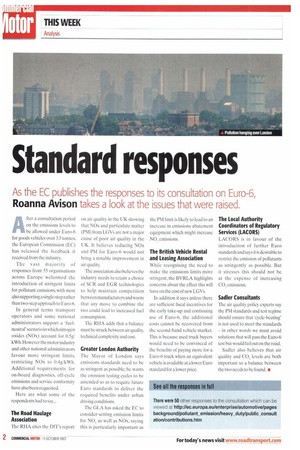Standard responses
Page 22

If you've noticed an error in this article please click here to report it so we can fix it.
As the EC publishes the responses to its consultation on Euro-6,
Roanna Avison takes a look at the issues that were raised.
fter a consultation period on the emissions levels to Pe allowed under Euro-6 for goods vehicles over 3.5 tonnes, the European Commission (EC) has released the feedback it received from the industry.
The vast majority of responses from 55 organisations across Europe welcomed the introduction of stringent limits for pollutant emissions, with most also supporting a single-step rather than two-step approach to Euro-6.
In general terms transport operators and some national administrators support a 'fuelneutral' scenario in which nitrogen oxides (NOx) account for 0.5g/ kWh. However the motor industry and other national administrators favour more stringent limits, restricting NOx to 0.4g/kWh. Additional requirements for on-board diagnostics. off-cycle emissions and service conformity have also been requested.
Here are what some of the respondents had to say...
The Road Haulage Association I he RHA cites the DfT's report on air quality in the UK showing that NOx and particulate matter (PM) from LGVs are not a major cause of poor air quality in the UK. It believes reducing NOx and PM for Euro-6 would not bring a notable improvement in air quality.
The association also believes the industry needs to retain a choice of SCR and EGR technologies to help maintain competition between manufacturers and warns that any move to combine the two could lead to increased fuel consumption.
The RHA adds that a balance must be struck between air quality, technical corn plexity and cost.
Greater London Authority The Mayor of London says emissions standards need to be as stringent as possible; he wants the emission testing cycles to he amended so as to require future Euro standards to deliver the required benefits under urban driving conditions.
The GLA has asked the EC to consider setting emission limits for NO2 as well as NOx, saying this is particularly important as the PM limit is likely to lead to an increase in emissions abatement equipment which might increase NO, emissions.
The British Vehicle Rental and Leasing Association While recognising the need to make the emissions limits more stringent, the BVRLA highlights concerns about the effect this will have on the cost of new LGVs.
In addition it says unless there are sufficient fiscal incentives for the early take-up and continuing use of Euro-6, the additional costs cannot be recovered from the second-hand vehicle market. This is because used truck buyers would need to be convinced of the benefits of paying more for a Euro-6 truck when an equivalent vehicle is available at a lower Euro standard for a lower price. The Local Authority Coordinators of Regulatory Services (LACORS) LAcoRs is in favour of the introduction of further Euro standards and says it is desirable to restrict the emission of pollutants as stringently as possible. But it stresses this should not be at the expense of increasing CO2 emissions.
Sadler Consultants The air quality policy experts say the PM standards and test regime should ensure that 'cycle-beating' is not used to meet the standards — in other words we must avoid solutions that will pass the Euro-6 test but would fail out on the road.
Sadler also believes that air quality and CO2 levels are both important so a balance between the two needs to be found. •


































































































































































































